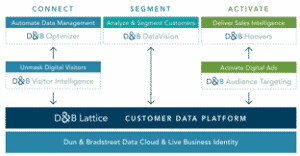Dun & Bradstreet can trace its history back to 1841, with the formation of The Mercantile Agency in New York City by Lewis Tappan, later renaming the business R.G. Dun & Company. By 1844 the Mercantile Agency had over 280 clients. The agency continued to expand allowing offices to open in Boston, Philadelphia, and Baltimore.
 In 1933, Dun merged with a competitor, John M. Bradstreet, to form today’s Dun & Bradstreet.
In 1933, Dun merged with a competitor, John M. Bradstreet, to form today’s Dun & Bradstreet.
In 1963, the company invented the data universal numbering system. On January 5, 2015, Dun & Bradstreet acquired the data management firm NetProspex.
In 2018, the company was acquired by an investor group led by CC Capital, Cannae Holdings and Thomas H. Lee Partners for $5.38 billion.
 The company generates revenue through subscription-based products, business information reports, data licensing agreements, strategic partnerships and concierge service. The company’s database contains more than 300 million business records worldwide.
The company generates revenue through subscription-based products, business information reports, data licensing agreements, strategic partnerships and concierge service. The company’s database contains more than 300 million business records worldwide.
Headquarters are located in Short Hills, New Jersey.
Dun and BradstreetDun & Bradstreet can trace its history back to 1841, with the formation of The Mercantile Agency in New York City by Lewis Tappan, later renaming the business R.G. Dun & Company. By 1844 the Mercantile Agency had over 280 clients. The agency continued to expand allowing offices to open in Boston, Philadelphia, and Baltimore.
 In 1933, Dun merged with a competitor, John M. Bradstreet, to form today’s Dun & Bradstreet.
In 1933, Dun merged with a competitor, John M. Bradstreet, to form today’s Dun & Bradstreet.
History
In 1963, the company invented the data universal numbering system. On January 5, 2015, Dun & Bradstreet acquired the data management firm NetProspex.
In 2018, the company was acquired by an investor group led by CC Capital, Cannae Holdings and Thomas H. Lee Partners for $5.38 billion.
 The company generates revenue through subscription-based products, business information reports, data licensing agreements, strategic partnerships and concierge service. The company’s database contains more than 300 million business records worldwide.
The company generates revenue through subscription-based products, business information reports, data licensing agreements, strategic partnerships and concierge service. The company’s database contains more than 300 million business records worldwide.
Headquarters are located in Short Hills, New Jersey.

